Saturday, August 31, 2013
Weapons of Mass Destruction – Live Sound
My wife and I showed up early to get good seats and my first indication that there was bad news on the way was the fact that the band’s crew appeared to be a sad mix of clueless kids completely out of their depth with the Avid monitor console and biker bar bouncers. The two kids spent the whole setup making “yup, yup” noises into Randolph’s SM58 and demonstrating a sort of ignorance that only music school graduates exhibit. Even the traditional “testing one, two, three” seemed beyond their grasp. Looking for a couple of friends we expected to join us, I ran into Michael and Claudia McKern near the back of the seating area and invited them to sit with us. They wisely declined with the expectation that the sound would be deafening and painful any closer than their nosebleed seats. I should have taken the hint right then. The show started on time and got going with more than few technical hitches as Randolph’s crew spent the first twenty minutes running on and off stage wrestling with instrument and microphone problems. Their lethargic stage setup and goofy concentration on unimportant trivia were a sure sign that show problems were on the way.
The sound company was a local vendor and I’ve heard this system before. It’s a small “array” system (a glorified term for speaker columns on steroids) that is incapable of reproducing anything more sophisticated than “the white zone is for parking” announcements. The only “quality” the system has is volume. Accuracy and frequency response have been sacrificed for output and the company has a habit of pushing their pitiful equipment far past it’s meager capabilities. Last night was no exception. My best description of the sound quality is “a really loud, but damaged, AM radio accompanied by an equally lo-fi cardboard tube subwoofer.” Mostly what was demonstrated was that throwing money at a lack of talent is just good money after bad. The people in charge of running this system are hearing impaired. No amount of equipment can fix deafness.
The sound of the kick drum was one of the two most disgusting options live sound clowns seem to have; lots of 100Hz with no definition and enough resonance in the system to make every kick strike ring for no less than half a measure, even on slower tunes. The bass guitar was equally indistinguishable from rumbling earthquake noises, except when Danyel Morgan slaps his bass which produced weird quacking sounds. The band’s great voices were reduced to public address system quality monotone speech. The rest of the mix was a wash of distortion and mid-range confusion. The only way this could have been worse would be to take it indoors where lousy acoustics would add to the mess.
The band struggled to generate energy with their technical handicap and produced some moments that transcended the sound system. As for us, we filtered from the front rows back to the street without any real improvement. The FOH clown was busy fooling with a personal computer or his cell phone during the worst moments of the show and he made no attempt to clean up the sonic mess he was making. Clearly, this band would be better off running sound from the stage without the interference of “professionals.” In fact, the best three shows I’ve seen this summer were all sans-soundmen. All of the worst shows had some fool in charge of the sound system whose job was, apparently, to create as much audio havoc as possible.
All of this reminded me of why I decided to quit making professional power amplifiers twenty years ago. “Sound reinforcement” is just a polite term for making loud noises intended to damage hearing on a large scale. There is no excuse for allowing this kind of audio garbage in a modern world. Musicians and the industry have no business complaining about MP3s or file-sharing when there appears to be no quality control in any aspect of live music. Nothing could sound worse than this kind of PA system with this kind of fool in charge. So, if our customers can’t hear the difference between high resolution audio and a 128kbs MP3, we only have ourselves to blame. Honestly, this kind of sound system is largely responsible for the fact that a whole generation is going deaf. A decibel meter anywhere in sight of the stage would have measured hazardous sound levels.
Postscript: The second night's show was better, musically, but the sound system was even worse, if that was possible. After almost a decade of looking forward to seeing and hearing the Robert Randolph Family Band live, I most likely won't make that pilgrimage again.
Monday, August 26, 2013
Product Review: Studio Projects B3
 The B3 was the first Studio Projects microphone I experienced. At Musictech College, we have a somewhat vicious policy of limiting students' access to microphones based on their time at the school. 1st and 2nd semester students are not allowed to use our best microphones and, until the B3s appeared, they were not allowed to use any of the school's large element condensers, except for some beat up AT 4033s. When the B3 appeared, at a $159 price point (street, including shock mount), it became difficult to tell who was getting the short end of the microphone selection stick.
The B3 was the first Studio Projects microphone I experienced. At Musictech College, we have a somewhat vicious policy of limiting students' access to microphones based on their time at the school. 1st and 2nd semester students are not allowed to use our best microphones and, until the B3s appeared, they were not allowed to use any of the school's large element condensers, except for some beat up AT 4033s. When the B3 appeared, at a $159 price point (street, including shock mount), it became difficult to tell who was getting the short end of the microphone selection stick.
We compared the B3 to a variety of "classic" comparable microphones: from both versions of the AKG 414 to Neuman's U87 and the B3 was never found to be a clear loser in any shootout. In some situations, the B3 was preferred to microphones that cost 10-40X as much. I've used my "matched set" of green dot B3s (there are red dot and blue dot B3s) everywhere from classical violin and flute to R&R kick drum. In between, I've used B3s in Blumline pairs on horn sections and a background chorus, X-Y and MS pairs on trap set overheads and acoustic guitars and a small string section, and as solo mics on toms, high hat, acoustic and electric guitar, violin, flute, trumpet, trombone, and voice (male and female). While the B3 wouldn't have been my first choice for some of those recording situations, the mic never embarrassed me. Even in a school environment, several of the recordings made with this microphone impressed professionals enough that they purchased the multi-track reel and took note of the microphone used.
The B3 offers three polar patterns: omni, cardioid, and figure-eight. The directional polar patterns are consistent out to several feet, although the critical distance in most of the studios where I've used my mics doesn't allow for much more than 6' source-to-mic before room reverb mucks up the recording. The B3 also provides a high-pass filter and a 10dB attenuator, but this is a 3-position switch that only allows a user to pick one option of three. That has been a hassle a few times, but it's usually not much of a problem.
The B3's proximity effect isn't pronounced (for a large element cardioid), but it's usable by an experienced vocalist and can add considerable low end when used close to a kick drum or tom or acoustic/electric bass. The high-pass filter accurately compensates for close (~2") proximity without tossing away the bottom end of the natural signal.
Personally, I think the B3 is a steal of a microphone. I've been expecting Studio Projects to raise the price for the past three years. Since they haven't, I suspect they are either manufacturing wizards or still waiting for the market to catch on to this incredible deal in a large element, programmable polarity, condenser microphone.
Monday, August 19, 2013
REVIEW: Studio Projects C4
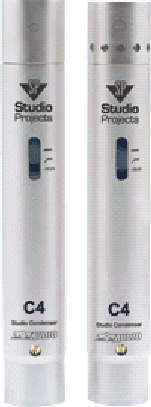 Here's what Studio Projects has to say about their C4 Condenser microphone:
Here's what Studio Projects has to say about their C4 Condenser microphone:
"The C4 is small diaphragm condenser microphone fe aturing interchangeable capsules, switchable -10dB pad/high pass filter and a linear low-noise, solid state amplifier body. The microphone’s modularity makes it a useful multi-purpose tool intended for all-around use on stage, on location and in studios of all caliber. "
No brag, just the facts. Musictech College hooked on to the Studio Projects microphones in 2002 to provide students with access to a high quality small element condenser mic that wouldn't cost the school an arm and a leg when a student found a way to misuse the mic as a drum stick (or a drum practice pad), The street price of a C4 pair is about $370. The C4 kit comes with a pair of microphone bodies, two each cardioid and omni capsules, shock mounts, and a solid storage case. A lot of bang for the buck. The mics met the school's requirement, but the real test was did they meet the instructor's expectations.
The answer was a resounding "yes."
We've found the C4s to be one of the most useful and accurate microphones we've used. For the price, I've never run into a better recording tool. These microphones are quick, clean, and precise. Used in close proximity to strings, acoustic guitars, or other moderate acoustic output instruments the C4s deliver a very credible representation of the instrument's actual output. Louder stuff requires the use of the C4's 10dB pad, but if what you hear is what you want on tape, the C4 is up to the task.
The omni capsule is specially precise. Without a proximity effect and with a very flat frequency response, the omni C4 is a wonderful tool for recording an acoustic environment. The cardioid C4 capsule is more "effected," but it is still a very smooth and accurate microphone, even when compared to studio standards like the SM81 or the 451B. It's hard to find a more uncontroversial recommendation than the C4 stereo condenser combination.
Of course there's always a downside. One downside to the C4 is the capsule replacement. Like most microphones of this style, the capsules thread on to the microphone body very carefully. The aluminum body and fine threads combine to make a very precarious initiation to mechanical devices for those who are not hand-to-eye skilled. In our school environment, we have few requirements for omni microphones which is a good thing because the students would have destroyed our C4s a year ago if there had been a need for them to replace the capsules.
Another picky fault of the C4 is its tolerance for humidity. It has none. In the early summer months, Minnesota gets warm and wet and so do our studios. Several times this spring, the humidity gauge in our main studios indicated 75%+ humidity and the C4s gave us a little indication of non-ideal conditions, too. Under these conditions, the C4s provided us with random low frequency sputtering noises that sounded a bit like intermittent cable connections, failing capacitors, or other pre-amp oriented noises. When the humidity dropped below 70%, the C4s quieted down. This isn't unusual behavior for small element condensers, so I'm not really picking on the Studio Projects offering, in particular. However, as a comparison, replacing the C4s in this situation with a pair of Shure KSM141s resolved the noise generation. Some microphones are more tolerant of mildly hostile environments than others.
Wednesday, August 14, 2013
Passion or Mastery?
I stumbled on an unusual book at the library this week and it has taken over my reading list until I wrap it up: Cal Newport’s So Good They Can’t Ignore You: Why Skills Trump Passion in the Quest for Work You Love. Having recently left teaching for a school that hyped the “follow your passion” delusion (The school’s demented marketing chant is “It's time to do what you love. Music is your life. You want a music school that connects you to the industry, to your inner voice, and to new worlds of possibility.”), this book struck more than a few chords with me, maybe a whole song worth.
While my institutional educational mandate was “turn half-interested hobbyists into professional recording engineers,” my personal goal was always to broaden the perspective of my students so they could see other opportunities for themselves. In case they discovered they weren’t going to be among the tiny percentage of folks destined to be rock stars or the slightly greater group employed as servants of rock stars (recording engineers), I hoped to put the bug of alternative career universes into their ears. Having watched Searching for Sugar Man last night, what I read this morning was even more relevant.
This search for meaningful work is a fairly modern human pursuit. For most of our million-something years, our ancestors mostly struggled to live through the seasons. We white folks, in particular, had winter to contend with and the usual population die-off associated with that stark season with the occasional complete failure of spring-summer-fall due to climate catastrophes. If you were from one of the southern hemispheres, your mileage differed only in that you substituted vicious and insane plutocratic governments and a lot more warfaring to keep the populations under control. If winter didn’t kills us, we killed us and the search for meaning was reduced to searching for a safe, warm place for our families and friends. The industrial age and, later, more sane socialist governments, created the middle class and that led to people wanting work with meaning and job satisfaction. This is a BRAND NEW THING, so we aren’t good at it yet.
Most parents who spent their lives either as the idle rich children (with careers consisting of calling their money managers and asking “Am I still rich?”) of the robber barons or the lucky few who lived a significant portion of their lives during the tiny historic moment of middle class aspirations (asking themselves “How the hell did I luck into this life?”), understandably, have no idea how to guide their kids toward a meaningful, successful life. Being a parent has always been a hard, mostly thankless job, but with a rapidly evolving job market, economy, and technology it’s a lot harder. Academic marketing doesn’t help, either. With a butt-load of higher ed and bullshit vocational schools hustling the “you have to have a degree to get a job” garbage, it’s harder than it needs to be. Being hovering, genetically “old” parents adds more calories to the lard, too.
This is where So Good They Can’t Ignore You gets really valuable. The author’s three rules are #1 Don’t follow your passion, #2 Be so good they can’t ignore you, #3 Turn down a promotion, #4 Think small, act big. I am not going to summarize the big points, because there is a whole book that does that better than I can and really efficiently. Sticking with #1, the passion thing, a Canadian studio listed Canadian university students as picking “dance, hockey, skiing, reading, & swimming.” If that list doesn’t demonstrate how useless passions are as career guides, I have a list of bridges I’d like to see you. You are clearly dumb enough to buy all of them, if I price them right.
One of my personal rules for career planning is “Don’t become expert at something you hate. You’ll have to do it for the rest of your life.” It is kind of the polar opponent to Newport’s #2 and it flies in the face of the idea that we can become wonderfully skilled without passion for a career. Live with it. It’s possible and a problem if you are the kind of person who wants to do everything well.
Monday, August 12, 2013
REVIEW: Heil Sound Proline PR30 & PR40 Dynamic Microphones
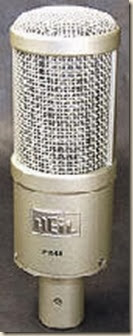 The first thing I noticed about these two microphones is that they appear to be styled after side-address large element condensers, but they are, in fact, front address moving coil microphones. Contrary to decades of microphone tradition, the Heil microphones place the logo somewhere other than at the front of the element which will probably confuse some users. One example of this might be the microphone used on Dave Letterman's desk, which appears to be aimed at the ceiling, as if it were a side address mic aimed at Dave or his guests. Dave doesn't seem to use this mic, since he can whack at it with a pencil without notice or audible side-effect, so maybe it doesn't matter where it's pointed.
The first thing I noticed about these two microphones is that they appear to be styled after side-address large element condensers, but they are, in fact, front address moving coil microphones. Contrary to decades of microphone tradition, the Heil microphones place the logo somewhere other than at the front of the element which will probably confuse some users. One example of this might be the microphone used on Dave Letterman's desk, which appears to be aimed at the ceiling, as if it were a side address mic aimed at Dave or his guests. Dave doesn't seem to use this mic, since he can whack at it with a pencil without notice or audible side-effect, so maybe it doesn't matter where it's pointed.
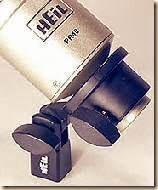 The second thing was the handling noise. One of the usual expectations for a dynamic mic is that it will be fairly immune to handling. Neither of these microphones meet t hat expectation. They are unusually sensitive to touch, sounds transmitted through the stand, or cable movement, so for practical applications they need shock mounting. This characteristic makes the PR30 and PR40 much like the large element condensers they hope to emulate, sonically, these microphones desperately need shock isolation. The good news is that Heil sells the SM-2 Shock Mount for a reasonable $89 and it might resolve many of these issues. I did not have that device to include in our tests, so I can't vouch for its performance. I suspect that some of the sonic comments made about the microphones, especially the PR30, might be moderated by shock mounting the mic.
The second thing was the handling noise. One of the usual expectations for a dynamic mic is that it will be fairly immune to handling. Neither of these microphones meet t hat expectation. They are unusually sensitive to touch, sounds transmitted through the stand, or cable movement, so for practical applications they need shock mounting. This characteristic makes the PR30 and PR40 much like the large element condensers they hope to emulate, sonically, these microphones desperately need shock isolation. The good news is that Heil sells the SM-2 Shock Mount for a reasonable $89 and it might resolve many of these issues. I did not have that device to include in our tests, so I can't vouch for its performance. I suspect that some of the sonic comments made about the microphones, especially the PR30, might be moderated by shock mounting the mic.
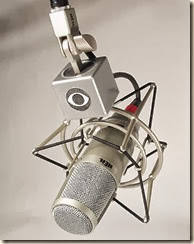 Another expectation of large dynamics is durability. FOH Ma gazine's Mark Amundson had done some testing of these microphones before I received them and the PR40 had suffered a small dent in the top screen from some of that experience. No other visible damage was noted, but the PR40 was intermittent when we received it. We returned it to Heil and it was repaired within a couple of weeks. In comparison, though, our Sennheiser MD421, Shure Beta52, EV RE20 & 868, and AKG D112 experience has been considerably different. Those mics have been dropped, bashed, dented, and tossed from tall buildings (effectively) without failure. I have to say the Heil mics are unexpectedly fragile, based on our PR40 experience.
Another expectation of large dynamics is durability. FOH Ma gazine's Mark Amundson had done some testing of these microphones before I received them and the PR40 had suffered a small dent in the top screen from some of that experience. No other visible damage was noted, but the PR40 was intermittent when we received it. We returned it to Heil and it was repaired within a couple of weeks. In comparison, though, our Sennheiser MD421, Shure Beta52, EV RE20 & 868, and AKG D112 experience has been considerably different. Those mics have been dropped, bashed, dented, and tossed from tall buildings (effectively) without failure. I have to say the Heil mics are unexpectedly fragile, based on our PR40 experience.
For a US-made product, the Heil Prosound PR40 ($325 list) PR30 ($289) are reasonably priced. Street price, currently, is very close to list, but that may change if distribution becomes wider. The PR40 comes in a nice looking "cherry wood case." It has solid construction and feels substantial. Both mics seem like quality products, but the heft of the PR40 leaves a better impression than does the lightweight PR30. The mics look alike, but they do not feel at all the same. The PR40 has decent pop filtering and the PR30 would require an additional pop filter for vocal use.
Sonically, I found both mikes to be somewhat more sensitive than similar dynamics. The PR40, for example, needed about 6dB less mic pre gain than an RE20 in the same application. The PR40 has a slightly pronounced lower midrange, which gives the PR40 a somewhat nasal quality on male voice. It's a little edgy sounding on female voices. I used it for both vocal music and speech and my opinion stayed the same for either application. Sound quality-wise, it recorded with a character more similar to good dynamics than condensers (contradicting the Heil marketing claims, "a dynamic that sounds like a condenser"). It has a pronounced proximity effect, so I can't see the PR40 replacing the RE20 in knowledgeable studios, but maybe there are fewer of those around than when the RE20 first became popular. As for the condenser "sound-alike" claim, I don't own any condensers that exhibit the limitations of the PR40. As for the claim that the PR40 is as sensitive as a large element condenser, I think those reviewers are on crack or unfamiliar with typical microphone gain requirements.
On instruments, I tried the PR40 on kick, floor tom, electric bass, and piano. The low end didn't do much for me on a variety of kick drum positions, but I could see using it as a floor tom mic. It has more bottom than a 421 or a D112, but it's not as solid and precise sounding as an RE20 or as big and full as a Beta52 or any of the similar modern kick mics. On electric guitar the PR40 has a quality of its own. It is very full, punchy, and cuts through the mix differently than either an SM57 or a condenser in the same application. The same can be said in an electric bass application. The things that make it less than ideal on some instruments, apparently, make it shine on bass or guitar. Because of the high sensitivity claim, I tried the PR40 on the low bridge of a grand piano and it was accurate and very musical in that application but still required only slightly less preamp gain than other dynamics I might consider for this application.
As I mentioned earlier, the PR30 didn't do much for me as a vocal mic. The lack of pop filtering and the tonal quality of our PR30 was very similar to what you'd expect from an SM57 in the same application. The PR30's early low roll-off makes it even less interesting as a kick mic. The low end is simply not there and the combination of poor isolation and the resonance of the mic made it a poor choice for percussion. It produces a strange ringing effect on high volume percussion sounds that is difficult to EQ out. On other instruments, I tried the PR30 on electric guitar, harmonica, and as a mono drum overhead. In a blues rock recording session, we mic'd a Shure Green Bullet-to-tube-amp combination and compared the PR30 to the Beta57 and SM57. The PR30 won hands-down. The narrow-band quality of the PR30 was exactly right for fitting the harp into a full blues mix and the response of the mic mellowed the instrument into something very traditional sounding for this style of music. On electric guitar the PR30 performed equally well. It takes high levels of sound pressure without issue and works well in a close-mic'd environment, providing decent isolation and a clear tone.
Bob Heil recommended trying the PR30 as an overhead drum mic, so I did. This isn't an application where I'd normally consider a dynamic, but it was an interesting experiment. Compared to small condensers in the same location, we weren't impressed. The PR30 did require considerably less gain than another dynamic in the same location might need, but transient distortion was obvious and the lack of fullness in the toms was equally apparent. I'm not sure what I was supposed to hear in this experiment but I didn't hear anything I thought would be useful in a high fidelity recording situation.
Comments made by other engineers using the PR30 were
- "The PR30 on a small cabinet guitar amp worked quite well. The guitar tones were articulate and well defined. The mic worked particularly well on thick distorted tones. It has some resonance around 1-2kHz that really focused the overdriven amp tone. On drums the PR30 was less successful. On kick drum the mic lacked low frequency depth. It sounded like the 200-400Hz range was happening, but below 200Hz things rolled off quickly. On both toms and kick the resonance around 1-2kHz created a ring that really altered the tone of the drum shell." (Rob Schlette)
- "Used [the PR40] on spoken word, male voice. More sensitive, especially to transients, than expected (for a dynamic). Picked up consonants particularly well, could be because it was an especially bright sounding mic. Compared to an EV RE-20, it seemed to lack a little depth but wasn't as demanding on the mic pre. Felt the mic was a little one dimensional compared to the industry standard vox mic." (Scott Jarrett)
Because of time constraints and the intermittent problems we had with the PR40, I didn't get any other opinions of the PR40. There have been a lot of raving reviews of these microphones both in industry magazines and among some engineers, so your mileage may vary. While I found several reasons to like these mics, I found even more (handling noise, fragility, and odd chassis resonances) to distrust them. I think they are a bit high priced for the value offered, but they are certainly cost-effective for an American made boutique product. I do not consider either mic a substitute for a quality condenser, but they are both interesting in typical dynamic applications.
Monday, August 5, 2013
REVIEW: Rode NTK
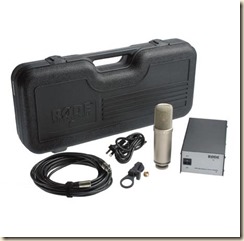 Here's what Rode has to say about their NTK Tube Condenser microphone:
Here's what Rode has to say about their NTK Tube Condenser microphone:
"The NTK employs a large 1” capsule gold-plated membrane, with hand-selected twin triode valves. One of the quietest tube mics in the world (< 12dBA self noise). 158 dB SPL handles loud sound sources with ease. Wide 20Hz – 20kHz dynamic range. Class A valve circuitry. Hand-selected and graded twin-triode valve. Dedicated power supply for optimum studio performance . . ." and so on.
I came upon the NTK as part of a large microphone shootout that I was putting together for a Recording Magazine article. Myself and two other listeners gathered almost $30,000 worth of microphones from our local Guitar Center's recording microphone collection, along with another $10,000 from my collection and the studio's gear. Almost as an afterthought, Guitar Center tossed in a new Rode NTK for our comparison testing. At the time, the NTK was going for about $800., discounted, so it seemed fair that we simply include it with the Neumann's, AKG's, Blue's, old Telefunken's, and the rest of the hoard. For a short while, the NTK could be had for less than $500, which might have caused me to do the test differently. I'm glad I didn't.
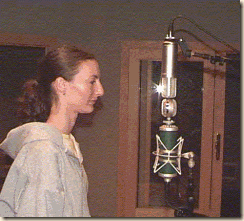 First, we carefully positioned all of the microphones in a restricted space, calibrated precisely to present the same axis and distance from our signal source for each test. An example of the test setup can be seen in the picture on the right. Unfortunately, this limited us to doing two comparisons at a time, instead of being able to mic one source for every test. I haven't been able to come up with a test that would allow for that kind of precision, so this was the best test I could design.
First, we carefully positioned all of the microphones in a restricted space, calibrated precisely to present the same axis and distance from our signal source for each test. An example of the test setup can be seen in the picture on the right. Unfortunately, this limited us to doing two comparisons at a time, instead of being able to mic one source for every test. I haven't been able to come up with a test that would allow for that kind of precision, so this was the best test I could design.
In the end, we found that one microphone stood out as having added a special quality to the vocal and acoustic guitar recording tests; the Rode NTK. Or maybe, this particular Rode NTK. The voice was more full, richer, more silky through the NTK. The acoustic guitar was fat, present, and clear and even when the test was limited by my guitar talents, it was obvious that this microphone added something incredibly special to the recording process.
My Guitar Center contact assured me that he'd never heard anything but rave reviews about the NTK and I was almost convinced that, if I didn't really "need" a large-element tube condenser, I could always buy one later. However, my distrust of all things electro-mechanical wouldn't let me give back the NTK and I ended up with another microphone in my collection.
I haven't regretted the decision, but I heard, not long after my purchase, that the NTK had become a little less predictable; that Rode's manufacturing process was turning out more "variety" in the NTK and some of those variations were less than ideal. I think the NTK is out of the Rode lineup now and has been replaced by a completely different product. Maybe this early entry mic was a "loss leader" that allowed Rode to position its products as upscale mics in a very competitive market. When they tried to reproduce the NTK to make a profit the quality suffered. I don't know this is what happened, but I've seen it before and I expect to see the tactic again.
Since buying my 1st NTK, I found a 2nd on eBay being offered by an Australian seller with the complete "broadcast package," including a shock mount, a pop filter, misc hardware, and a case. I took a chance and found that this 2nd NTK exactly matched my original mic. So there is hope that you might, also, find one of these rare jewels amongst the lesser versions of the same model. Listen closely, unless you get a great deal, because all Rode NTKs are not equal.
